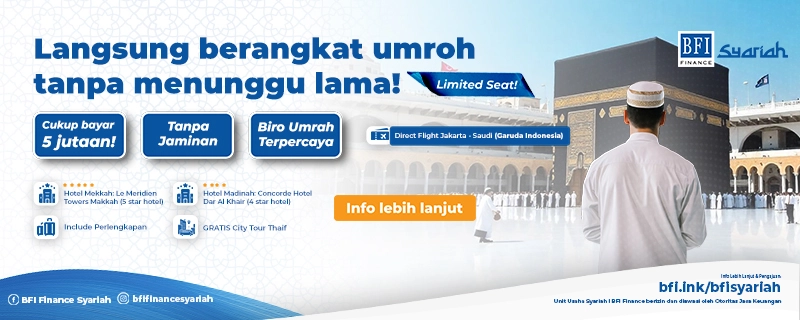There are many types of houses in Indonesia. Some of the houses that are quite popular include cluster houses, town houses, and residences. On this occasion, the BFI Finance Team will discuss cluster-type houses, starting from their definitions, characteristics, advantages and disadvantages, to the differences between townhouses and residences. Come on, see more in the following article!
1. What is a Cluster House?
For those of you who don't know what a cluster-type house is, this is the right time to get to know this house more closely.
Cluster houses are types of landed houses that are built in a complex and consist of tens to hundreds of housing units. This type of house generally has a uniform shape and size and does not have a fence on the front. One house and another house are only separated by a concrete wall.
Apart from having a similar house design, cluster housing is generally equipped with quite complete supporting facilities. Starting from security, parks, sports fields, and so on.
Many people tend to choose this type of house because it has a good and closed security system. In other words, not just anyone can enter this residential area without permission from security. Needless to say, outsiders who visit the cluster housing area are often asked for identification such as KTP before being allowed to enter.
2. Characteristics of Cluster Houses
As with other types of houses in Indonesia, cluster houses have their own characteristics that make them different from other houses. Here are some characteristics you need to know.
2.1. Same House Design and Building
Cluster houses are located in a complex or residential area with uniform buildings. If you are in a housing complex with the same building design and shape, then you can be sure that the housing is in the cluster house category.
2.2. Has Complete Facilities that are Shared
Cluster houses are equipped with supporting facilities that can be shared with other housing residents. Such as green open spaces, playgrounds or playgrounds, sports fields, swimming pools, and so on.
2.3. One Gate System
This type of house has limited access, and not everyone can enter it without permission. They use a one-gate system or a one-door system that allows access to and out at the same door with 24-hour surveillance and is equipped with CCTV so that anyone who enters can be identified by security. Not surprisingly, the dwellings inside are among the safest even though they are not equipped with fences.
2.4. Have Multiple Units
In a cluster, there are quite a lot of units, ranging from tens to hundreds. The process of building houses in it is carried out in stages (step by step) from one cluster to another.
2.5. Tanpa Pagar
This type of housing carries an open theme where homeowners and others can mingle easily. No wonder the cluster houses are not equipped with guardrails between one house and another. In addition, the absence of this guardrail can facilitate access in and out for homeowners and guests who come.
Homeowners also don't need to worry because the existing security system allows vehicles to always be kept safe.
Also Read: The Cost of Building a 2-Story House and Other Important Things
3. Advantages and Disadvantages of Cluster Houses
When it comes to choosing a home, of course, there are several factors to consider. Generally, these factors include advantages and disadvantages. So, what are the advantages and disadvantages of cluster houses?

Cluster House Illustration. Image Source: Pexels/Eziz Charyyev
3.1. Advantages of Cluster Houses
1. Complete and Adequate Shared Facilities
There are various facilities that can support productivity and entertainment for residents of cluster areas. Starting from playgrounds, sports venues, tennis courts, and many more.
2. 24-Hour Guaranteed Security
The cluster house security system is guaranteed 24-hour surveillance and is equipped with CCTV. So, all people who enter and leave the housing will be recorded by the security section. Not surprisingly, even though the houses inside are not fenced, the cluster housing will still be safe.
3. Comfortable Environment
For those of you who have children, the environment you live in is definitely a separate consideration. So, in cluster housing, you don't need to worry when your children are playing around the house. The reason is, passing vehicles will not be as busy as ordinary housing. Children will also be comfortable and safe when playing outside the home.
4. High Investment Value
Cluster housing is synonymous with strategic development locations. This allows homeowners to reach public facilities more quickly and efficiently. For example built near major roads, train stations, malls, and many more.
With easy access to these places, cluster houses have a high selling value from year to year. So, if you want to invest in property, this type of house is the right choice for you. The more strategic and complete the facilities offered, the higher the investment value.
5. Suitable For Children
Cluster houses have 24-hour security and generally have a playground inside. This point is one of the reasons why this type of house is suitable as a long-term residence for those who have children.
3.2. Disadvantages of Cluster Houses
It's not fair if we don't discuss the shortcomings of cluster houses. Even though it's almost perfect, in fact, there are some flaws in this house.
1. Monotonous Design
Because the existing buildings in this housing are uniform from one to another, it makes the existing design seem monotonous. One house with another does not have a clear difference. Another case is with ordinary housing which is identical to the various facades of the house.
2. The Need for Additional Fees
Not only paying for electricity and water, those of you who own property in cluster housing, are required to pay other additional costs. This fee is the cost of maintaining the environment which consists of security costs, garbage collection, road cleaning, and others depending on the applicable policies.
3. High Price
Cluster houses are built in strategic places and close to public access such as highways, train/MRT stations, malls, toll roads, and so on. The existence of this ease of access makes the sale value of a property priced at higher price.
Also Read: House Facades: Definition, Functions, Types of Materials, and Examples
3.3. Differences between Cluster Houses and Other Types of Houses
When compared with other types of houses, here are some differences that appear between cluster houses and townhouse and residence types.
3.4. Cluster Houses with Townhouses
Not a few people think that cluster houses are the same as town hall houses. In fact, the two have quite obvious differences, especially in the target market two, where townhouses are more intended for the elite or the upper middle class.
1. Home Design
The cluster house design is the same as other housing units and carries the concept of open green housing. While townhouses generally consist of several housing units with a fence on the front.
Clusters compose a minimalist concept because their target market tends to be all circles. Unlike the townhouses which are intended for the upper class.
2. House Size
Cluster-type houses have a larger size when compared to townhouses. This is because cluster-type houses provide more open space.
3. House Price
The price per cluster housing unit is priced at an expensive price because it is located in a strategic place with quite complete facilities. However, this price is not as expensive as a townhouse-type house where per unit is valued starting from billions.
4. Ownership
Clusters are restricted properties that anyone can have. While townhouses are generally inhabited by expatriates or the elite who live in Indonesia. Not surprisingly, townhouse-type houses are more exclusive.
The number of townhouses tends to be limited, unlike cluster houses which consist of many units.
5. Facilities
The facilities in the cluster are indeed quite complete. However, townhouse housing offers more complete and adequate facilities because it has an exclusive concept.
Also Read: Tips, Types, and Calculation of Home Renovation Costs [New]
4. Cluster House with Residence
Here are some differences that appear between cluster houses and residential houses.
1. Location
Cluster houses are in busy areas and near public facilities. Meanwhile, residences are generally located in suburban areas or the outskirts of large cities.
2. Number of Units
Cluster houses have a larger number of units and can even number in the hundreds. Meanwhile, the number of residences is less.
3. The Atmosphere Offered
Clusters carry the theme of open space or open space, this is also the reason why the houses in the cluster area do not have guardrails. Where residence or residential areas are generally equipped with a guardrail on the front of the house and have different facades.
4. Existing Facilities
Clusters are supported by various facilities that can support their residents. Starting from the one-gate system, playgrounds, sports fields, and many more. Another case is with the residence which is much simpler.
5. House Price
Finally, the price of the house offered. Cluster houses have a higher value than residences. This can happen because the cluster is located in a strategic location with a more complete line of supporting facilities.
BFI friends, that was the discussion regarding cluster houses. Are you interested in owning it? If you plan to buy a house or renovate it, but you still lack funds, you can apply for a fast loan at BFI Finance!
BFI Finance is a company that provides multi-purpose loans with guarantees for motorbike bpkb, car bpkb, and house or shophouse certificates






